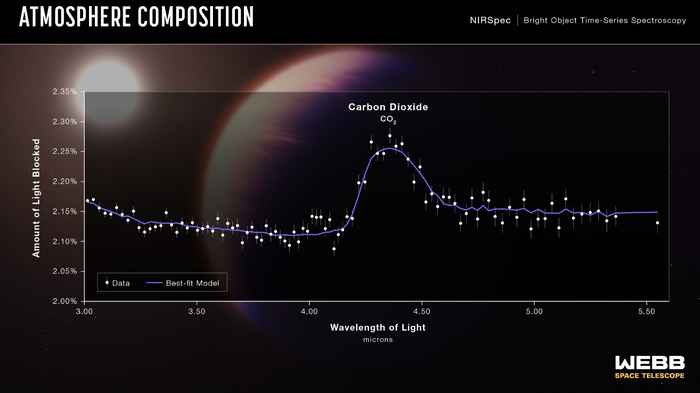JWST detects carbon dioxide in exoplanet’s atmosphere
25 August 2022

The planet is WASP-39 b, a hot gas giant with a mass approximately a quarter that of Jupiter (and about the size of Saturn) and a diameter 1.3 times that of Jupiter. The fact that it is so extremely swollen is partly related to its high temperature (approximately 900°C). Compared with the cooler, more compact gas giants in our solar system, WASP-39 b orbits its star at very close proximity - only about an eighth of the distance between the Sun and planet Mercury - and completes an orbit in just over four days.
Filtered starlight
As seen from Earth, WASP-39 b passing directly in front of its star. During transit, a planet obscures a little of the starlight and its atmosphere allows some starlight through. The atmosphere filters certain colours better than others, depending on factors such as composition, thickness and the presence of cloud. As different gases absorb different combinations of colour, researchers are able to analyse small differences in brightness of the light that filters through over a spectrum of wave lengths to determine exactly what an atmosphere consists of. WASP-39 b is an ideal subject for transmission spectroscopy as its atmosphere is swollen and the planet often transits its star. The team used Webb’s near-infrared spectrograph NIRSpec for their observations.
First clear detection of carbon dioxide
To the scientists, this first, clear, detailed and irrefutable evidence of carbon dioxide surrounding a planet outside our solar system augurs well for detection on smaller, rocky planets. Natalie Batalha of the University of California in Santa Cruz, USA, who is leading the team of scientists studying these so-called transiting exoplanets with Webb: 'Even without the robust carbon dioxide property, this spectrum would have been notable. No single observatory has ever measured such subtle differences in brightness in the 3 to 5.5 micron range in the transmission spectrum of an exoplanet before. Access to this part of the spectrum is of crucial importance for measuring concentrations of gases such as water, methane and carbon dioxide, which we assume to be present in many different types of exoplanets.'
'Insight into the composition of the atmosphere of a planet is important as it tells us something about the origin of the planet and how it has evolved,' adds co-author Yamila Miguel, who worked on models and the interpretation of the data. Jean-Michel Désert: 'By measuring this carbon dioxide property we can determine how much solid and how much gaseous material was used to form this gas giant. Over the next ten years, Webb will be performing these kinds of measurements for various kinds of planets. This will give us greater insight into the process by which planets come about, and the question whether our own solar system is unique.'
Early Release Science
WASP-39 b’s NIRSpec observations are part of a larger study in which various other methods and instruments have been used, including for observations of two other planets transitioning their stars. This study forms part of the Early Release Science programme, which was started to provide the exoplanet research community with Webb data as soon as possible. 'Our goal is to analyse the Early Release Science observations immediately and to develop instruments with which in future anyone will be able to analyse Webb data,' Oxford University’s Vivien Parmentier explains. 'This will ensure that these observations generate the best science.'